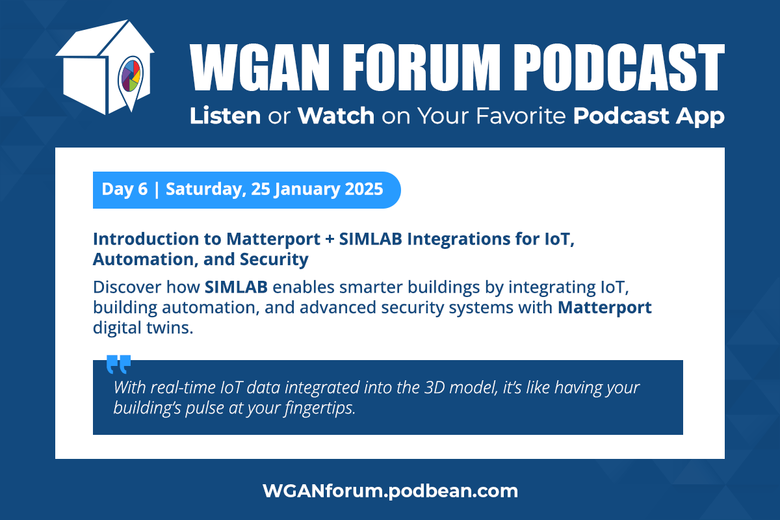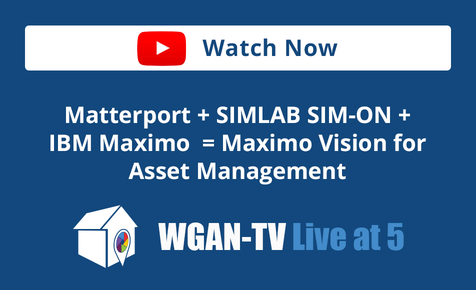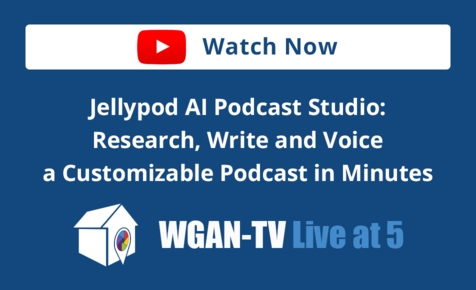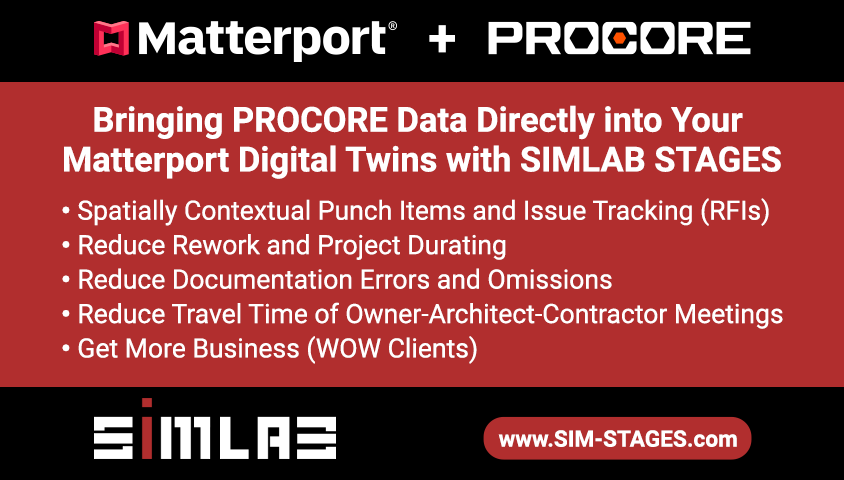Day 6: SIMLAB Integrations: The Glue That Holds It All Together20662
Pages:
1
 WGAN Forum WGAN ForumFounder & WGAN-TV Podcast Host Atlanta, Georgia |
DanSmigrod private msg quote post Address this user | |
| SIMLAB is a WGAN Marketing Partner ---  SIMLAB Week on WGAN Forum Podcast | Day 6 (Bonus Day): SIMLAB Integrations: The Glue That Holds It All Together | Saturday, 25 January 2025 WGAN Forum Podcast: SIMLAB Week on WGAN Forum Podcast[/b] | Day 6 (Bonus Day): SIMLAB Integrations: The Glue That Holds It All Together | Saturday, 25 January 2025 | @Jedrzej @SimlabSales @SIMLAB Day 6: SIMLAB Integrations: The Glue That Holds It All Together Hi All, Day 6 of SIMLAB WEEK on the WGAN Forum Podcast (Saturday, 25 January 2025) wraps up with an in-depth exploration of SIMLAB Integrations. This bonus show dives deep into how SIMLAB connects with industry leaders to create a powerful, seamless ecosystem for AEC professionals, facility managers, and beyond. Highlights: ✓ Matterport + NavVis: High-quality digital twins for design, planning, and operations. ✓ Procore Integration: Streamlined project management and collaboration. ✓ NETxAutomation Partnership: Building systems that communicate seamlessly. ✓ IBM Maximo Integration: Predictive maintenance powered by AI. ✓ Smart Building Automation: Real-time IoT and security integrations with Schneider Electric, VingCard, and more. This episode unpacks how SIMLAB's partnerships empower stakeholders across the building lifecycle, from creating smarter buildings to reducing costs and enhancing collaboration. SIMLAB Links SIMLAB SIMLAB STAGES SIMLAB SIM-ON Watch or Listen to Day 6 (Bonus Day): ✓ Watch on YouTube ✓ Listen on Podbean Transcript Highlights - [Host 1] It's the bonus day of SIMLAB Theme Week. - [Host 2] Bonus day! - [Host 1] So we're going to, we're taking a deep dive today. - [Host 2] Okay. - [Host 1] All about integrations. - [Host 2] Ooh, integrations! The glue that holds it all together. - [Host 1] Yeah, especially for AEC folks and facility managers out there. - [Host 2] Right, right. - [Host 1] This is where like SIMLAB really shines, I think, you know? - [Host 2] Yeah, yeah. - [Host 1] They're connecting with all the big players in the tech world to like bring some serious power. - [Host 2] Mm. - [Host 1] To the AEC world, to the built environment. - [Host 2] It's kind of mind blowing when you think about it. - [Host 1] Yeah, by the end of this, you're going to have a really good idea of how these integrations are shaping the future. Like how we design buildings, - [Host 2] Yes. - [Host 1] How we build them, how we manage 'em, the whole thing. - [Host 2] The whole shebang. - [Host 1] The whole nine yards. The whole- - [Host 2] Enchilada. - [Host 1] Enchilada, there you go. - [Host 2] Yeah, and it's really cool, because SIMLAB gets it. They understand that, you know, real world problems. You can't just throw one tool at it. - [Host 1] Right. - [Host 2] So they've built these two platforms, STAGES and SIM-ON, and they've partnered with some seriously heavy hitters in the industry. - [Host 1] Yeah, the A-team of the AEC world. - [Host 2] Exactly, and they've done this across five key areas, creating a truly connected ecosystem. - [Host 1] Right, let's break it down. - [Host 2] Yeah. - [Host 1] What are those five areas? I'm seeing like 3D scanning, mapping. - [Host 2] Oh, absolutely. Got to start with the foundation, right? - [Host 1] Yeah. - [Host 2] And that's where companies like Matterport and NavVis come in. They're the rock stars of digital twins. - [Host 1] Digital twin. That's like the virtual replica of the building, right? - [Host 2] Exactly, you're talking about a high-quality, super accurate 3D scan of a space, whether it's an existing building or even a construction site. - [Host 1] So you can literally walk through it virtually. - [Host 2] Yeah, and not just walk through it. You can use it for design, planning, operations, maintenance. - [Host 1] Yeah. - [Host 2] The possibilities are endless. - [Host 1] Okay, so we've got our digital twin. What happens next? How do we actually build this thing? - [Host 2] Well, that's where Procore steps in. It's all about project management and collaboration. - [Host 1] Okay, so like keeping everyone on the same page, contractors, architects, everyone. - [Host 2] Exactly, streamlining workflows, making sure everyone's got the latest info. No more miscommunication or delays. - [Host 1] Love it, so Procore helps manage the project, but what about the actual building systems like the HVAC, the lighting, all that good stuff? - [Host 2] That's where it gets really cool. We're talking about NETxAutomation. This integration is all about making sure all the different building systems can communicate seamlessly. - [Host 1] Okay, so everything's talking to each other from the start. That's got to save a ton of headaches down the road. - [Host 2] Oh yeah! We're talking about fewer errors, less rework, a much smoother process overall. - [Host 1] All right, starting to see the big picture here. Digital twin from Matterport, project management with Procore, and building systems talking to each other, thanks to NETxAutomation. That takes us through design and construction. - [Host 2] Yeah. - [Host 1] But what happens when the building is finished? - [Host 2] Time for the facility managers to take over. - [Host 1] Right, enter SIM-ON. - [Host 2] Exactly, and this is where those integrations really shine for facility managers. We're talking about asset and property management, IoT, building automation, and of course, security. - [Host 1] Whoa, there's a lot packed in there. Let's start with asset management. What kind of integrations are we talking about? And what's the benefit for facility managers? - [Host 2] Think about IBM Maximo. It's a giant in the asset management world. - [Host 1] Yeah, I've heard of them. - [Host 2] This integration lets facility managers combine traditional asset management with this super-cool thing called predictive maintenance. - [Host 1] Predictive maintenance. Tell me more. - [Host 2] It's all about using data and AI to predict when equipment might fail. So instead of waiting for something to break down- - [Host 1] You're ahead of the game. - [Host 2] Exactly, you can address potential problems before they even happen. Fewer surprises, less downtime, and massive cost savings. - [Host 1] Sounds amazing. But how accurate are those predictions really? What if something unexpected happens? - [Host 2] That's a great question. And while no system is perfect, these predictions are getting more and more accurate all the time, because they're based on tons of real-time data and powerful algorithms. And even if something unexpected does happen, facility managers can respond quickly and efficiently, because they have that real-time data at their fingertips. - [Host 1] Okay, so it's not just about preventing problems, but also reacting faster when they do occur. Makes sense, so we talked about IBM Maximo. Any other key players in this area? - [Host 2] Definitely, integrations with Fidelio Opera and Infor are specifically designed for the hospitality and real estate industries. So you're getting really tailored property management tools for those unique sectors. - [Host 1] Smart, okay, let's move on to IoT and building automation. This is where it feels like we're stepping into the future. - [Host 2] Right, it's all about creating truly smart buildings. - [Host 1] I'm picturing a facility manager in their office looking at a 3D model of their building on SIM-ON. - [Host 2] And they can see real-time data from all the building systems, thanks to integrations with major protocols like KNX, EnOcean, Modbus, and BACnet. - [Host 1] Wow, so they have their finger on the pulse of the entire building. - [Host 2] Exactly, and with partners like Schneider Electric, FIBARO and Helvar, they have incredible control over lighting, HVAC, security systems, pretty much everything. - [Host 1] So we're not just talking about monitoring data, but actually controlling the building in real-time. That's next level. What does that mean for a facility manager on a day-to-day basis? - [Host 2] It means they can optimize energy consumption, improve occupant comfort, and use resources more efficiently. They can adjust the lighting based on who's in the building, fine tune the HVAC for optimal performance, and even automate routine tasks like security checks. - [Host 1] That's incredible. So much time and money saved. - [Host 2] Exactly, and it frees up facility managers to focus on more strategic initiatives. Instead of putting out fires all day, they can focus on improving the building's performance and the occupant experience. - [Host 1] Love it, but we can't forget about security. That's a major concern for any building. - [Host 2] Absolutely, and SIMLAB has that covered too. Integrations with companies like VingCard, Kaba, and Salto bring in some really advanced access control solutions. - [Host 1] So we're talking keyless entry, mobile credentials, that kind of thing. - [Host 2] Yep, you can manage access permissions for every door in the building from SIM-ON. It's all about making buildings smarter and more secure. - [Host 1] All right, so we've gone through all five areas of integration. We've seen how SIMLAB is connecting with all these industry leaders to create this seriously powerful ecosystem. It's pretty amazing. But what does it all mean for the people actually using these tools? - [Host 2] It's all about empowering stakeholders across the entire life cycle of a building. - [Host 1] Okay, break that down for me. - [Host 2] Well, for facility managers, it's like having a central command center, one platform to manage everything from assets and maintenance to security and energy consumption. For AEC professionals, it means streamlined workflows, better collaboration, and the ability to catch costly errors early on. - [Host 1] Right, so everyone's working together more effectively. - [Host 2] Exactly, and then you have real estate developers who can create truly smart buildings, attracting tenants and investors with spaces that are sustainable and efficient. And finally, financial institutions and insurers can use the detailed data from these integrations to assess risk more accurately and streamline their processes. - [Host 1] It's like SIMLAB is taking all the complexity out of building management and creating the seamless integrated experience. - [Host 2] Exactly, and it's not just about technology. It's about making the lives of everyone involved in the built environment easier and more efficient. - [Host 1] Well said. This has been an incredible deep dive into the world of SIMLAB integrations. - [Host 2] It really has. - [Host 1] If you're ready to take your own deep dive, head over to www.SIMLABinc.com, - [Host 2] That's www.SIMLABinc.com - [Host 1] And fill out the Contact Us form. They'll be happy to answer any questions you have. - [Host 2] And don't forget to check out the WGAN-TV Podcast series featuring SIMLAB. - [Host 1] Oh yeah, that's a great resource. - [Host 2] You can find it at: WGAN.info/SIMLABonWGAN - [Host 1] They have some really cool episodes that go even deeper into specific integrations. - [Host 2] Yeah. - [Host 1] And how they're being used in the real world. - [Host 2] Definitely worth checking out. - [Host 1] It's exciting to think about what the future holds, you know? - [Host 2] Yeah. - [Host 1] Like imagine a world where buildings can practically manage themselves. Optimizing energy use, anticipating maintenance needs, adapting to the needs of occupants. SIMLAB is really leading the way. - [Host 2] It's an exciting time to be in the built environment, that's for sure. - [Host 1] Absolutely, all right, that's it for our deep dive today. Thanks for joining us. - [Host 2] Thanks everyone. - [Host 1] We'll see you next time. |
||
| Post 1 • IP flag post | ||
Pages:
1















